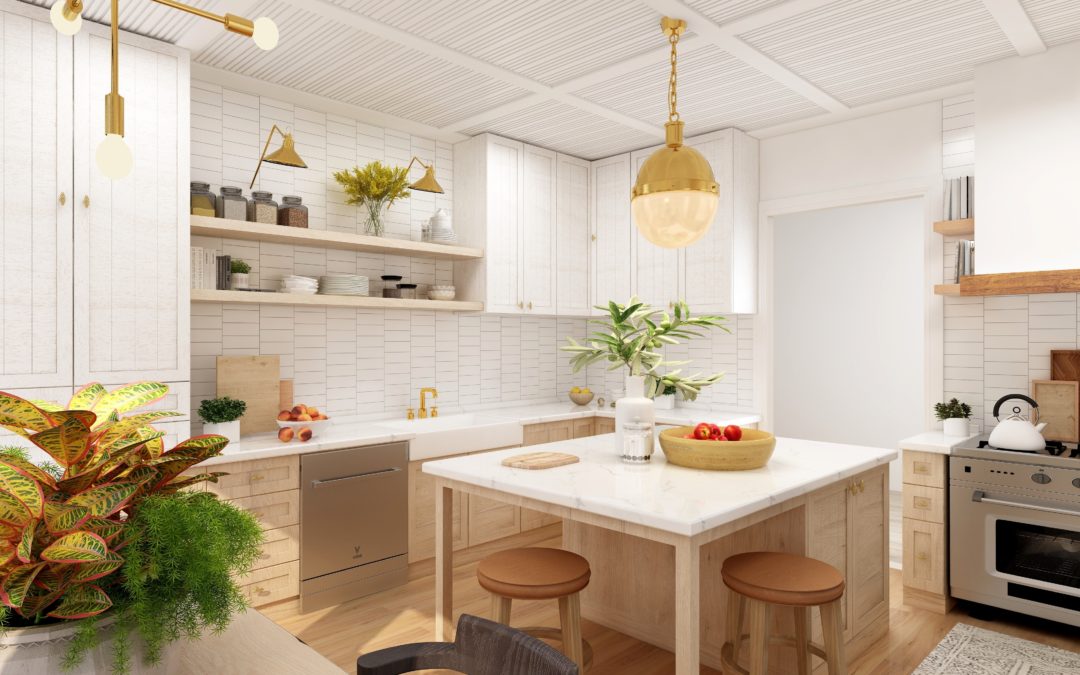If you’re planning a kitchen remodel, you’ll want to make sure your newly designed space is both beautiful and functional. From placing your appliances to ensuring the proper cabinet height, every little detail matters. Let’s take a look at some great kitchen layout ideas to inspire your upcoming project.
Great Ideas for the 6 Most Popular Kitchen Layouts
A clever layout can make all the difference when it comes to getting the most out of your kitchen space. If your kitchen’s a bit small and cramped, the right layout can make the most efficient use of floor space. On the other hand, if your kitchen has more space than you know what to do with, the right layout can help fill it up and make it cozy.
Below, we’ve outlined six of the most common kitchen layouts, as well as some tips to make the best use of them. Let’s dive in!
1. One-Wall
The one-wall kitchen is probably the simplest kitchen layout out there. Typically used in smaller kitchens, it lines up all cabinets and appliances along a single wall. Although it’s not really possible to create a traditional “work triangle” with this layout, there are ways to make it more functional.
To make a one-wall kitchen layout work best, try one or more of these tips:
- Space out your appliances. Consider placing your fridge at one end of the wall, your stove/oven in the middle, and your sink on the other end.
- Think vertically. Utilize the wall space you have, and take your cabinets as far up as possible — but be sure to store your lesser-used items up top to leave plenty of easy-to-reach room for the items you use every day.
2. Galley
A galley kitchen consists of two parallel rows of cabinets that create an inner pathway, or “galley,” between them. It’s a pretty basic layout, but it’s a space-efficient and affordable choice for small- to medium-sized kitchens.
If you’re thinking of going with the galley kitchen layout, consider the following:
- Choose between symmetrical and asymmetrical. Will your two rows run the same lengths, or will one be a little shorter than the other? Will your tall cabinets and appliances be centered on one side, or will they be sporadically placed on both?
- Use windows to open space. Galley kitchens can start to feel cramped, fast. Place a window on one side to let some natural light in. Or, try a pass-through window into another living area in your home!
3. L-Shaped
The L-shaped kitchen layout is a good choice for both small and large kitchens. It features two rows of cabinets and appliances along perpendicular walls. Although the L-shape does pose a challenge with utilizing corner space, there are plenty of great kitchen storage solutions to make good use of it.
Check out these L-shaped kitchen layout ideas to ensure you’re maximizing work, storage, and dining space:
- Keep the “L” legs less than 5 meters long. Especially in large kitchens, it’s easy to get carried away and make a huge workspace — but that doesn’t really pay off when you have to move long distances between appliances and workstations.
- Find a special corner storage solution. Whether you choose a lazy susan or a walk-in pantry cupboard, make sure you’re not wasting any space hidden in the corner.
- Build a breakfast nook in the opposite corner of the “L.” With L-shaped kitchens, you’re usually left with some space on the opposite side of the room. Fill it with a breakfast nook to create a cozy dining or entertaining space.
4. U-Shaped
U-shaped kitchens feature cabinetry and appliances along three adjacent walls. This layout works great for some but can get really cramped for others, which is why it’s best to only choose it for a larger kitchen. When implemented in the right space, U-shaped kitchens allow for multiple users and great workflow.
Interest in a U-shaped kitchen? Consider these tips before you get building:
- Don’t put upper cabinets on all three walls. Things will get cramped. Instead, place upper cabinets along one or two walls, then put open shelving or your stove hood on the other.
- Keep window areas open and uncluttered. Again, this is an effort to open up the space a bit more and let some light shine in.
5. Island
The island kitchen layout has gained a ton of popularity in homes with open floor plans. Islands provide a great surface for food prep, cooking, dining, and storage underneath. However, it’s important to make sure your kitchen is big enough to fit an island — otherwise, it just cramps up the room and becomes a barrier to efficient workflow.
If you’d like to install an island in your kitchen, make sure to do the following:
- Make ample use of it for storage. An island doesn’t just provide an extra surface — there’s also tons of room for storage underneath!
- Choose the right size. An island that’s too big for your space will restrict your traffic flow. An island that’s too small for your space will just look out of place.
6. Peninsula
Peninsula kitchens are similar to island kitchens, except the countertop is attached to one wall. This is a better solution for kitchens that are too small to have an island sit independently.
For peninsula layouts, you’ll want to keep the same considerations in mind as with an island kitchen — plus these:
- Find a special corner solution. Whether you choose a lazy susan or a walk-in pantry cupboard, make sure you’re not wasting any space hidden in the corner.
- Don’t install large appliances in the peninsula. Usually, peninsulas are better off being used for food prep or dining spaces.
Need advice on your new kitchen layout design? We’re here to help. At Zeeland Lumber & Supply, our experts have years of experience providing kitchen design solutions that function great and look even better. Contact us today to get your project started.

